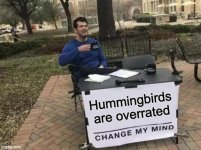As for milestones, for years I've had the number 3000 in my head (without guides). I'm at 2518 currently so I'll almost certainly get there a few year from now.
After that, I'll perhaps focus on specific families, e.g. see all hummingbirds (of which I'm currently at 101/366)
There are a couple of tricky birds there, security wise, and a good number of tricky birds, difficulty/logistics wise.
Glow-throated is hard to access (Cerro Hoya) and far from guaranteed once there.
Colorful Puffleg is basically not accessible for security reasons though occasionally it is semi-palatable for the intrepid.
Gorgeted Puffleg is AFAIK totally still not doable due to security.
Santa Marta Sabrewing is close to being accessible. It was a bit of a unicorn for some time with the supposed sightings largely being very stringy. Now, finally, sites for it are known but Colombian researchers and guides are working with the communities to setup tourism before all hell breaks loose, so not quite yet.
Chiribiquete Emerald is doable at the moment, you can fly in and get it at the airstrip.
Sooty Barbthroat is very hard and requires days of persistent searching in one spot in French Guiana to have a fair shot. Even better, the subsp in Amapá, BR, may well be a good species and is much less known and presumed to be more difficult.
Rufous-webbed Brilliant is AFAIK still extremely difficult, I've not heard of any reliable individuals or sites, ever, just a couple of lucky encounters for folks who have spent enough time in the right areas.
Short-crested Coquette is in a very sketchy area. There was a window a couple years ago where a few people managed to see it but the area's gotten spicy again and AFAIK it's off limits again.
White-tailed Hummer is in the same area as SC Coquette but I think there might be a safe site for it in Oaxaca for those who are willing to put in some legwork.
Buff-breasted Sabrewing is, I believe, recently possible in PN Canaima (Venezuela) after being logistically nearly impossible for basically ever.
A few of the Amazonian hummers can just take a really long time to connect with depending on luck, ie Fiery-crested Awlbill, Black-bellied Thornbill, Raquet-tipped Thorntail, Butterfly Coquette come to mind.
Plenty of species, ie some of the other Coquettes, Humboldt's Sapphire, Black-breasted Puffleg, Diamantina Sabrewing, etc can be challenging depending on if you can get to a good site at the right time of year and have a bit of luck, they require some dedication.
Plenty of species are sort of "well doable" but logistically difficult or expensive like Juan Fernandez Firecrown, Chiribiquete Emerald, the Tepui species, Blue-bearded Helmetcrest, etc.
If the Phaethornis Hermits get further split there likely will be some pretty hard ones in there too!
I'm sure I'm forgetting a few as well. I've seen just over 300 species but of all the ones I brainstormed above, I've only seen 4. I do not anticipate ever cleaning up the hummers...











